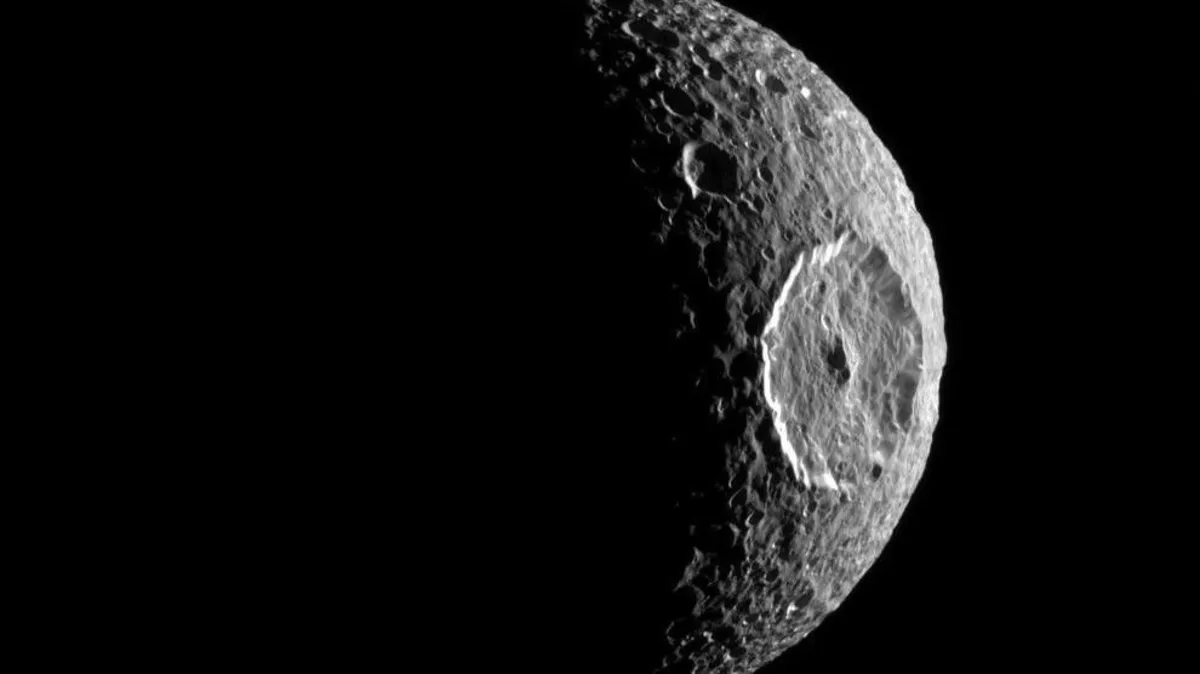
The growing evidence for a newborn ocean on Saturn's moon Mimas is becoming increasingly compelling. Recent research focused on mapping the thickness of Mimas' icy crust not only sheds light on the potential age of an existing ocean but also identifies the areas where the crust is thinnest. These regions are prime candidates for future missions aimed at directly detecting the ocean beneath Mimas' surface.
During a recent presentation at the joint Europlanet Science Congress-Division for Planetary Sciences meeting, planetary scientist Alyssa Rhoden from the Southwest Research Institute in Boulder, Colorado, highlighted the peculiar characteristics of Mimas. Unlike its fellow moons, such as Enceladus and Europa, which exhibit surface features indicative of oceanic activity—like cracks and crevasses—Mimas appears relatively unscathed. Its surface is marked by craters that look as if they were carved from solid rock rather than ice, leading to questions about the moon's geological history.
Last year, researchers utilizing data from NASA's Cassini spacecraft provided substantial support for the hypothesis of a relatively young ocean beneath Mimas. Initial skepticism surrounding this notion has given way to a stronger consensus, backed by detailed observations that suggest an ocean lies buried under 12 to 19 miles (20 to 30 kilometers) of solid ice.
Rhoden and her team employed models based on the heat shell thickness of Europa to analyze Mimas. Their findings indicate that once melting begins, it progresses rapidly. The melting process on Mimas is closely linked to its orbital dynamics. Although the exact formation history of Saturn's moons remains uncertain, scientists propose that any primordial ocean Mimas may have had has long since frozen over. The current possible ocean is seen as a recent phenomenon, likely resulting from changes in the moon's orbital path.
As moons orbit planets, gravitational interactions create tidal forces. On Earth, this is observable as the changing tides influenced by our moon. Similarly, the gravitational pull of Saturn affects Mimas, and research suggests that a shift to a more eccentric orbit has generated enough heat to melt the ice, possibly forming a newborn ocean. However, as Mimas' orbit gradually becomes more circular, the tidal forces that sustain this ocean may diminish, leading to a slow refreezing of the water.
Rhoden and her colleagues simulated the potential changes in Mimas' orbit, concluding that a significant shift would have led to the complete melting of its surface, erasing craters and other geological features. Their analysis indicates that this orbital change likely occurred within the last 10 to 15 million years, a brief period in astronomical terms, aligning with earlier estimates for the age of the potential ocean.
Mimas is often referred to as the "Death Star moon" due to its resemblance to the iconic space station from Star Wars. The Herschel crater, which spans 80 miles (130 kilometers) across, plays a crucial role in the ongoing discussion about the existence of an ocean beneath Mimas. The characteristics of craters can reveal significant information about the moon's geological past. The analysis of Herschel suggests that the ice could not have been entirely rigid during its formation, indicating that Mimas was likely on the verge of melting when the crater was created.
Planetary scientist Adeene Denton, also from SwRI, noted that Mimas must have remained near this melting threshold for millions of years, allowing researchers to refine the timeline of Herschel's formation from a million to potentially ten million years ago. This adjustment is significant for understanding the geological history of Mimas.
At the center of the Herschel crater lies a central peak, formed by the impact of a large object. Research indicates that a collision with solid ice would not produce a peak, suggesting that Mimas may have had a subsurface ocean at the time of impact. If this ocean existed, the collision would have resulted in a chaotic dispersion of water, preventing the formation of a central peak.
Denton emphasized that Herschel likely formed during a transitional period when the ice was warmer but not entirely liquid. This ongoing research contributes to a broader understanding of Mimas, painting a coherent picture of this intriguing moon as a potential young ocean world. As scientists continue to explore Mimas, they aim to unravel the mysteries surrounding its icy crust and possible ocean, paving the way for future exploratory missions.